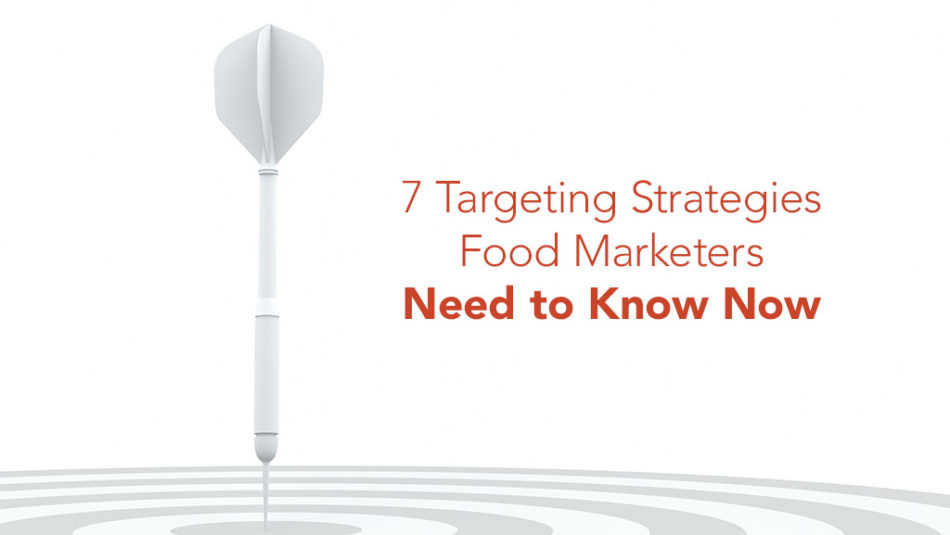
7 Targeting Strategies Food Marketers Need to Know Now
These days, food magazines and grocery shelves seem filled with new products for very specific audiences—plant-based meat alternatives; allergen-aware cookies and snacks; sustainably-grown, aquaculture fish and shellfish. Luckily, thanks to the current digital media offerings as well as the shift to digital-like capabilities of more traditional media such as streaming TV and digital Out of Home, there is a lot of data available to food marketers, large and small, to find very precise targets. Food and beverage companies can benefit from finding the perfect target audience for their product and running customized creative to target that audience. There are several targeting strategies available such as:
- Demographic
- Behavioral
- Contextual
- Psychographic
- Geographic/Location
- Attribution
- Privacy Compliant Identifiers
Each of these strategies breaks your audience down by different characteristics and behaviors. The form of advertising being used, budget, and target market, will help narrow down which strategy is the right fit for your marketing efforts.
Demographic
There are many ways to slice up demographics—gender, age, race, income levels, education, size of household, etc. This is the way media has been measured and purchased for a long time. However, demographic targeting has evolved with the digitization of media. Instead of having to buy TV the way it has been purchased in the past (i.e., buy a TV program that has the highest concentration of your specific target audience possible), you can now buy just the audience you want. For example, digital video vendors like Hulu or Roku (sometimes referred to as Over-The-Top or OTT TV) and online video purchased through platforms such as YouTube or Vimeo can sell a specific audience instead of a program. The detailed data these platforms have on who is using their service allows a food advertiser to eliminate spending on audiences that aren’t the right fit. This targeting strategy is best for new or growing food advertisers who are trying to drive awareness for their product by reaching a broad audience such as Women 25-54 with children.
Behavioral
Behavioral targeting uses people’s activities online to group them into segments that can then be used to purchase media. This can be a company’s own data (i.e., what people do or don’t do on a company’s app or website) or third-party data (e.g., people who go to food sites or download recipes). Food advertisers who have target audiences defined by their online habits are best for this type of strategy. For example, a stuffing brand that wants to increase usage outside of Thanksgiving by targeting consumers predisposed to their product might target light users who come to their website for cooking tips during the holidays.
Contextual
Contextual advertising refers to the practice of placing ads on web pages based on the content of those pages. For example, this could be ads for probiotic yogurt in a health article about digestive problems, or it could be ads for casual dining restaurants on a local business directory site. This is done through contextual targeting on an ad network, which involves segmenting ads based on parameters like keywords or website topics. This strategy works best when an advertiser is looking to gain benefits from the content they’re advertising within–be it credibility like the yogurt example or local affiliation like the restaurant example.
Psychographic
Psychographic targeting uses consumers’ general activities, interests, and opinions to understand the cognitive factors that drive their behaviors. This includes emotional responses and motivations; moral, ethical, and political values; and inherent attitudes and biases. These factors can then be used to create segments to target media with. Many platforms have psychographic data about their users that can be applied to targeting. For example, a frozen pizza brand looking to drive sales for super bowl weekend can target people on Facebook who include a favorite football team in their profile. There are also many third-party companies that have psychographic data that can be used for targeting. In addition, if a brand has first-party psychographic data but not at scale, they can work with companies to develop look-alike audiences based on that information. Brands that psychographic targeting performs well for are categories where products are similar and the brand’s personality and/or values align with specific consumers’ personalities and/or values.
Geographic/Location
Like demographic targeting, geographic targeting is something marketers have been doing for a very long time using local TV and radio to target key markets or unwired networks to reach a specific region of the country. However, geographic targeting has evolved with more precise data. Now advertisers can narrow audiences down much further to the zip code or even zip plus 4 levels. In addition, there are location companies such as Foursquare and Cubiq that have the ability to target based on location through tracking a panel of mobile devices across the country. Some examples include targeting frequent shoppers for a retailer you are stocked in to get them to buy your product when they are in store – or targeting consumers who visit a competitor’s location with an ad to convince them to visit your location. Geographic targeting is suited for products with limited distribution or in regions with highly concentrated usage.
Attribution
Attribution is a really important area of data and analytics these days. With the ability to track consumers from ad view to product purchase, it enables marketers to finally answer the old adage by John Wanamaker, “Half the money I spend on advertising is wasted; the trouble is I don’t know which half”. From a targeting standpoint, a brand can target audiences that purchased products to encourage repeat purchases or find look-alike audiences of consumers who purchased their product to bring in new consumers. In addition, marketers can see which audiences saw their ad and dropped off somewhere along the path to purchase and then create a target out of these consumers to encourage them to complete the sale. Brands that are selling direct to consumers are a natural fit for attribution targeting. Conversely, brands selling their product through a variety of third-party vendors will find this type of targeting more challenging. However, a number of retail media networks such as Instacart (which covers multiple grocery retailers) and retailer owned networks such as Walmart Connect or 84.51 (Krogers’ network) provide targeting based on their shoppers. Also, almost any product has some outlet that advertising can be attributed to that would be useful for targeting, even if it isn’t a direct sale, such as downloading a recipe from their website.
Privacy Compliant Identifiers
Privacy compliant identifiers are a new solution to a problem that is top of mind among both consumers and brands: privacy and transparency of data. There have been a number of laws and acts passed over the last few years by different states and countries, such as California’s Consumer Privacy Act and the EU’s General Data Protection Regulation, as well as changes in technology like Apple’s OS14 anti-tracking that rolled out in 2021. All of this has been done to provide more privacy for consumers (by letting them opt out of data sharing) and more accountability for companies (by pushing them to be more transparent in how they track consumers and how they use customer data).
The advertising and marketing community has been wrestling with this situation for a while, trying to find a way to market more effectively to their ideal customer without overstepping and creating a backlash by taking advantage of them. A number of advertisers are trying out privacy compliant identifiers as a way to do this. Either by using anonymized IDs provided by a supplier such as The Trade Desk’s UID2 or Epsilon’s Core ID or by accessing data segments that anonymize individual user data such as Experian and Ampersand’s partnership with the AND platform. This type of targeting is still being developed so right now this is best for brands looking to stop relying on individual data and want to test and learn how to make this type of targeting work.
It’s an exciting time in the world of marketing, but to borrow from Spider-Man, with power comes great responsibility. While the plethora of data that is available to food marketers makes finding the best target for their product easier than it has before, they need to offer value back to the consumer (e.g., great products that they really want, information that makes their life easier, recipes that they enjoy) to make it an equal exchange and one that can continue and strengthen the bond and loyalty between food advertisers and their audiences.






